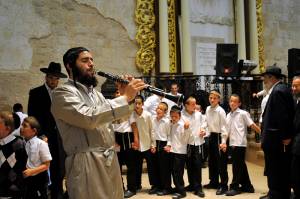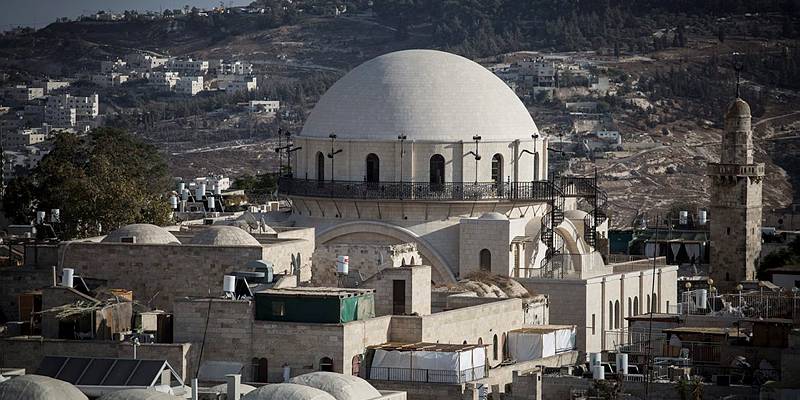The Old City of Jerusalem is the heart of the Jewish people. Understanding the synagogues and yeshivot (study halls) of the Old City and their history is a fascinating way to measure the heartbeat throughout the generations.
When Jewish communities are feeling safe and strong, beautiful synagogues and yeshivot are built at the center. When Jewish communities are under attack, it’s often these places that are the focus of the attack, such as with Kristallnacht (the Night of the Broken Glass) – November 9 and 10, 1938 – when 1,000 synagogues throughout Nazi Germany and Austria were destroyed.
In 2005, when the Israeli government evacuated and dismantled all of the 21 Jewish communities (the Katif Bloc) from the Gaza Strip, it was decided to leave the synagogues standing so that Jews wouldn’t have to destroy them with their own hands. Immediately after Israel left, the local population delighted in burning and desecrating the empty buildings.
Before the War of Independence in Israel (which broke out November 29, 1947, when the United Nations voted on the partition plan for a Jewish and an Arab state), there were dozens of beautiful, historic synagogues in the Old City, the oldest dating back to 1267, when Jewish life had been re-established in Jerusalem by leading Jewish scholar Nachmanides (also known as the Ramban).
Jordan’s army, known as the Arab Legion, showered the Jewish Quarter with mortars launched from the Mount of Olives, and eventually entered into the Old City, purposefully desecrating and destroying every synagogue and yeshiva they could find. Abdullah el-Tell, who was leading the forces attacking the Old City and later became the military governor of the Old City of Jerusalem when it was under Jordanian control from 1948 to 1967, said that they would destroy everything Jewish, so that the Jews would never be able to return to the Old City.

A Sukkkot 2011 celebration inside the newly renovated Hurva Synagogue. (Serge Attal/Flash90)
Dozens of synagogues and yeshivot were destroyed, but they are slowly being rebuilt. It’s exciting to visit the large, white, domed synagogue at the center of the Jewish Quarter, known as the Hurva (Ruins), which was rebuilt and opened in 2010. Visitors can also enjoy seeing the beautiful Ohel Yitzchak, near the Western Wall, which was rebuilt and opened in 2008. Another large, domed synagogue, the 119th-century Tiferet Yisrael is currently being excavated prior to reconstruction. Below its remains are homes that belonged to Jewish leaders of Jerusalem 2,000 years ago!
It’s amazing to see that not only did the Jewish people return to Jerusalem and rebuild, but, as a result of the bombings, discovered ancient Jewish history that had been buried underneath!
In the entire Old City, there was only one Jewish holy place that was completely untouched in 1948, called Yeshivat Torah Chaim. This yeshiva and community had been under attack in the riots of 1929 and the 1930s. By 1938, they had to leave, but asked an Arab neighbor to watch their place in exchange for payment. Every year, they would return to pay him. In 1948, Jordan captured the area, and the Arab understood that they would not be coming back very soon.
In 1967, during the Six Day War, Jerusalem was unexpectedly reunited under Israeli control. One of the soldiers who was serving in the Old City remembered that his grandfather had been the Rosh Yeshiva (dean of the study hall) of Torat Chaim and decided to see what had become of it. After asking around, he found an Arab man in the market who motioned to him to speak softly and follow him. They walked up the stairs into the nearby building and the man pulled out a hammer. He then proceeded to knock down a wall. Behind the fake wall, which the Arab man had constructed, was the entire yeshiva, just as they had left it in 1938, with thousands of books in Hebrew and Yiddish.
This righteous man explained that more than he protected the holy books, the holy books had protected him and his family. He is considered as one of the people who protected Jews during the Holocaust. Today, this yeshiva is called Ateret Yerushalayim (also known as Ateret Cohanim) and is once again the center of a thriving Jewish community.
By: Leah Bowman
(The author, a licensed tour guide, leads inspiring tours throughout Israel, including child-friendly and bible tours. Check out her website and blog page.)

Free Ebook: 10 Best Places to Visit in Israel
The Land of Israel has provided the backdrop for some of the most important events in human history. From the Old City in Jerusalem to the Sea of Galilee, people from all over the globe visit the Holy Land each year to take in the breathtaking scenery and inspiration of Israel. Now you can experience this beauty for yourself from the comforts of home and maybe plan a trip of your own to Israel. Get the free, exclusive eBook from United with Israel: The 10 Best Places to Visit in Israel.
